The CFA Institute Asset Manager Code is a valuable guide for asset management firms that aspire to high standards. The purpose of the Asset Manager Code is to foster a culture of ethical and professional behavior that protects the interest of investors, protects and enhances the reputation of the investment firms. It also provides a useful framework for asset management firms to provide services in a fair and professional manner with full disclosure. The Code helps asset managers gain the confidence of clients, ultimately leading to higher profits.
Broadly speaking, there are six general principles to the Code:
Managers must
- Act in a professional and ethical manner at all times
- Act for the benefit of clients
- Act with independence and objectivity
- Act with skill, competence, and diligence
- Communicate with clients in a timely and accurate manner.
- Uphold the applicable rules governing capital markets.
The details matter. In this article we’ll examine the key sections of the Asset Manager code.
There are six sections to the Code:
- Loyalty to Clients
- Investment Process and Actions
- Trading
- Risk Management, Compliance and Support
- Performance and Valuation
- Disclosures
Loyalty to Clients
A firm must prioritize clients interests ahead of firm and employees, maintain confidentiality, and refuse inappropriate gifts or business relationships.
Firms need to develop policies and procedures to ensure that client interests are paramount in all aspects of the manager-client relationship. This includes things like investment selection, transactions, monitoring and custody. Managers should avoid situations that create conflict of interest. Moreover they should implement compensation arrangements that ensure these interests are aligned, and no in conflict.
This also includes being careful to maintain client confidentiality (ie a privacy policy). This of course does not apply if information must be legally disclosed.
Asset managers also need to be careful to avoid getting into business relationships that create conflicts of interest. This can be challenging for due diligence analysts who constantly receive gifts from potential investments.
Investment Process and Actions
This requires reasonable care and judgment when making investment decisions, fair dealing, sufficient due diligence, and avoiding manipulation of securities prices and volume.
A rigorous due diligence process is part of the Asset Manager code. This means using reasonable care and prudent judgement in setting the investment policy, and having a reasonable and adequate basis for all investment decisions.
Manipulating securities market, or treating clients unfairly is a violation of this part of the code. Note that this provision doesn’t prohibit side-letter arrangements, als long as they are fairly allocated among similarly situate clients for whom the opportunity is suitable.
The CFA Institute provides additional guidance on this part of the code that pertains to the differences between managing pooled funds and separate accounts. When a pooled vehicle has a specific mandate, strategy, or style, the investors should take only investment actions that are consistent with those constraints or objectives. If there is any change in the investment style or strategy, you should inform investors before making the changes. That way clients can decide if the new strategy still fits with their objectives.
When managing separate accounts there are additional subtleties. You should evaluate and understand the client’s objectives, risk tolerance, time horizon, liquidity needs, financial constraints and unique tax, legal, and regulatory constraints that would impact the policy. Only make decisions that are suitable for clients given these circumstances.
Trading
This section includes not using material non-public info for trading purposes (regardless of local law), the prioritization of clients over the firm, the proper use of client commissions, and making sure your clients get best execution and the development policies of fair and equitable trade allocation.
Firms need to establish compliance procedures to ensure they avoid insider trading.
Additionally, they need to give priority to clients made on behalf of the client over those that benefit the Manager’s own interests.
Commissions generated from trades should only be used t o pay for investment related products or services that assist in the investment management process, not with management of the firm. This goes back to the general principle of putting clients first. Closely related, Managers need to seek best trade execution for clients. This can add a lot of value for strategies that deal in illiquid securities, or make large investments. As with everything else, the firm needs to document this with proper policies and procedures.
Risk Management, Compliance and Support
The asset manager code requires detailed policies and procedures in order to ensure compliance with the Asset Manager Code. The firm’s compliance department needs to develop extensive written policies and procedures to ensure that all activities comply with the Asset Manager Code, and with all legal and regulatory requirements.
The compliance officer should be independent from investment operations if possible. Additionally, they should report directly to the CEO or board. The compliance officer also needs to make sure all client communications are accurate and complete. Additionally, third party confirmation is essential. Maintain records for at least seven years, or as required by local law. Keeping top quality staff isn’t just good business sense, its also required by the Asset Manager Code. A disaster recovery and business continuity plan is also part of this section of the Asset Manager Code.
The firm should establish a firmwide risk management process that identifies, measures and managers the risk position of the manager. An effective risk management process will identify risk factors for individual portfolios, as well as for the manager itself. This includes, stress tests, scenario testa, and backtests.
Performance and Valuation
The asset manager code requires the use of fair market prices or commonly used valuation methods, as well as data that is accurate, relevant, timely and complete.
Managers need to present performance data that is fair, accurate, relevant , timely and complete. Its critical that managers must not misrepresent hte performance of individual portfolios or their firm. The GIPS standard provide a good standard, although its not required. MAnagers should not cherry pick performance, or take credit for performance that occurred before they took over management.
Some securities can be hard to value. The code requires Managers to use fair market prices to value client holdings and apply, in good faith, methods to determine the fair value of any securities for which no independent third party market quotation is available. Management fees are generally calculated based on asset valuation, so this has the potential to crate a major conflict of interests. The best practices is to transfer responsibility to an independent third party. For pooled funds with independent directors, best practices is to have independent directors review valuation.
Disclosures
Disclosure is a theme that runs through all sections of the Asset Manager Code . Firms must provide ongoing , timely communications with clients. These communications must be truthful, accurate, complete, and understandable. Moreover these communications must include all material facts regarding the firm, personnel, investments, and the investment process.
Key guidance for disclosure:
- Communicate with clients on an ongoing and timely basis. Managers should establish lines of communication that fit with their situation.
- Ensure that disclousrs are truthful, accurate, complete and understandable and a re presented in a format that communicates effectively.
- Include any material facts when making disclourures or providing information to clients regarding htemselves, their personnel, investments, or the investment process.
- Things that require disclosing include
- Conflicts of interest from relationships with brokers or other entities, other client accounts, fee structures or other matters
- Regulatory or disciplinary actions against the manager.
- Thei investment proces , including information regarding lock up periods, strategies, risk factors, and use of derivatives and leverage
- Management fees and other investment costs charged to investors, including what costs are included and methodologies for determining fees and costs.
- The amount of any soft or bundled commissions, the goods and or services received, and how they benefit client
- Performance of clients investments on regular basis. The CFA Institute recommends at least quarterly when possible, and within 30 days after th end of the quarter
- Valuation methods used – must be specific, not boilerplate
- Shareholder voting policies
- Trade allocation policies
- Results of the fund audits.
- Significant personnel changes
- Risk management processes.
By adopting this code, firms demonstrate their commitment to ethical behavior and the protection of investor interests.









